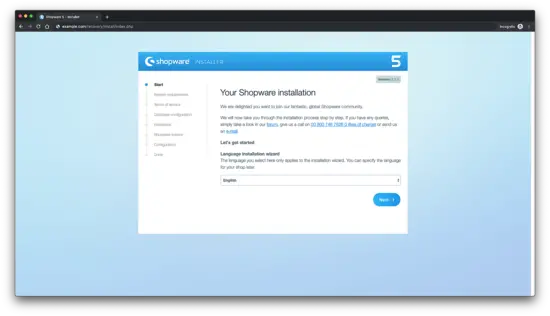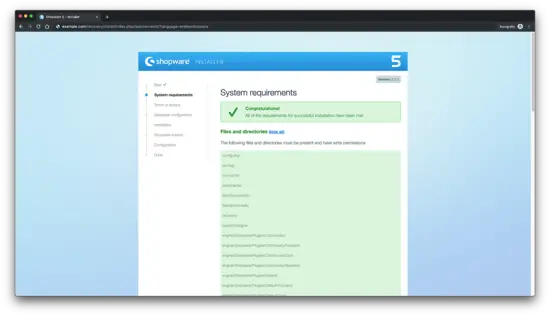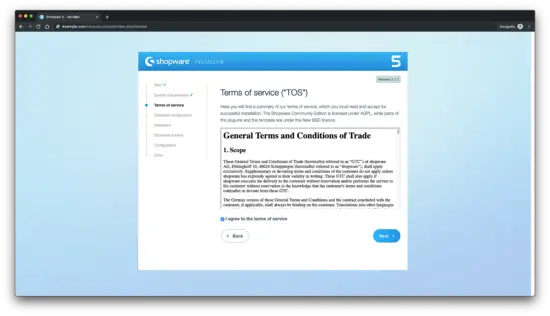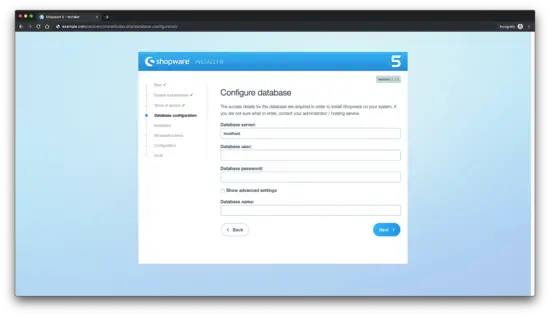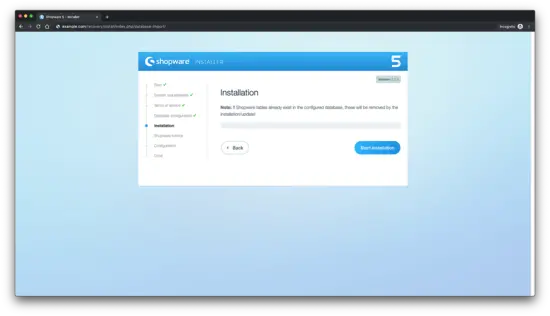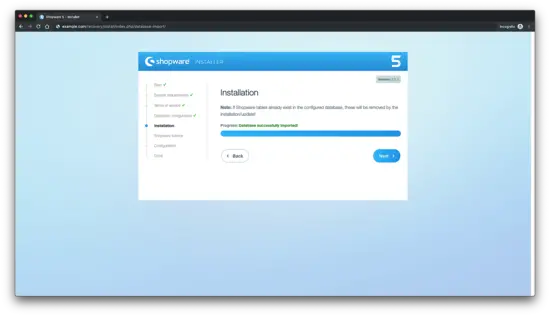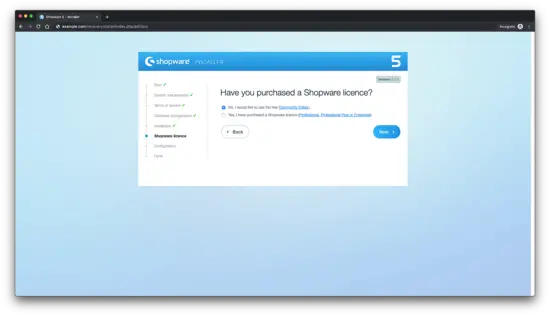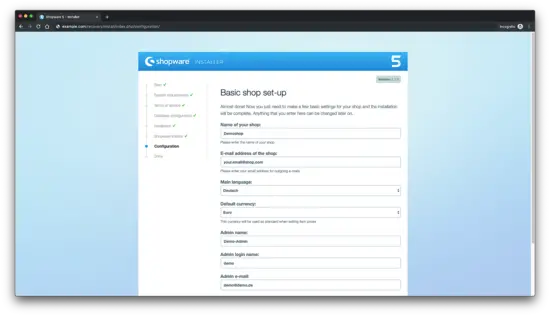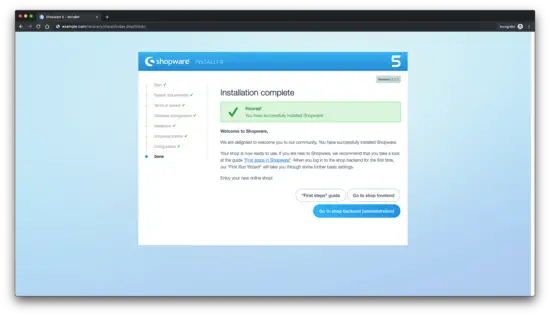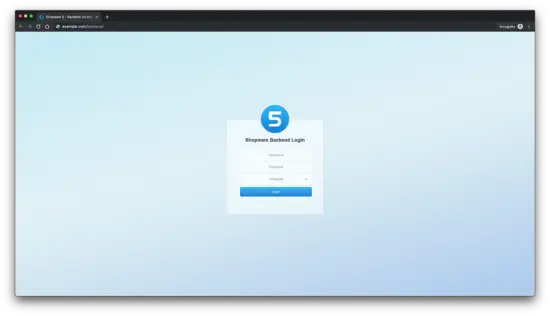How to Install Shopware with NGINX and Let's Encrypt on Fedora 30
On this page
- Requirements
- Prerequisites
- Step 1 - Install PHP and PHP extensions
- )
- Step 3 - Install MariaDB and create a database for Shopware
- Step 4 - Install Acme.sh client and obtain Let's Encrypt certificate (optional)
- Step 5 - Install and configure NGINX
- Step 6 - Install Shopware
- Step 7 - Complete the Shopware setup
- Links
Shopware is the next generation of open source e-commerce software. Based on bleeding edge technologies like Symfony 3, Doctrine2 and Zend Framework Shopware comes as the perfect platform for your next e-commerce project. This tutorial will walk you through the Shopware Community Edition (CE) installation on Fedora 30 system by using NGINX as a web server.
Requirements
Make sure your system meets the following minimum requirements:
- Linux-based operating system with NGINX or Apache 2.x (with mod_rewrite) web server installed.
- PHP 5.6.4 or higher with ctype, gd, curl, dom, hash, iconv, zip, json, mbstring, openssl, session, simplexml, xml, zlib, fileinfo, and pdo/mysql extensions. PHP 7.1 or above is strongly recommended.
- MySQL 5.5.0 or higher.
- Possibility to set up cron jobs.
- Minimum 4 GB available hard disk space.
- IonCube Loader version 5.0.0 or higher (optional).
NOTE: Shopware 5 is currently up to PHP 7.2.x compatible.
Prerequisites
- An operating system running Fedora 29.
- A non-root user with sudo privileges.
I will be using the domain name example.com in this tutorial. Please replace the word example.com with your own domain name wherever it occurs in the commands and config files below (especially in the nginx config file and the Let's encrypt commands).
Initial steps
Check your Fedora version:
cat /etc/fedora-release
# Fedora release 29 (Twenty Nine)
Set up the timezone:
timedatectl list-timezones
sudo timedatectl set-timezone 'Region/City'
Update your operating system packages (software). This is an important first step because it ensures you have the latest updates and security fixes for your operating system's default software packages:
sudo dnf upgrade -y
Install some essential packages that are necessary for basic administration of the Fedora operating system:
sudo dnf install -y curl wget vim git sudo unzip socat bash-completion
Step 1 - Install PHP and PHP extensions
Install PHP, as well as the necessary PHP extensions for Shopware:
sudo dnf install -y php php-cli php-fpm php-common php-mysqlnd php-curl php-json php-zip php-gd php-xml php-mbstring php-opcache
To show PHP compiled in modules, you can run:
php -m
ctype
curl
exif
fileinfo
. . .
. . .
Check the PHP version:
php --version
# PHP 7.2.16 (cli) (built: Apr 30 2019 08:37:17) ( NTS )
# Copyright (c) 1997-2018 The PHP Group
# Zend Engine v3.3.5, Copyright (c) 1998-2018 Zend Technologies
# with Zend OPcache v7.3.5, Copyright (c) 1999-2018, by Zend Technologies
Start and enable PHP-FPM service:
sudo systemctl start php-fpm.service
sudo systemctl enable php-fpm.service
We can move on to the next step, which is the IonCube Loader installation.
Step 2 - Install IonCube Loader (optional)
This step is optional because Shopware works without IonCube now, but there might be still extensions or themes that use IonCube, so it does not hurt to install it. Download IonCube Loader:
cd /tmp && wget https://downloads.ioncube.com/loader_downloads/ioncube_loaders_lin_x86-64.tar.gz
Extract the loader:
tar xfz ioncube_loaders_lin_*.gz
Find the PHP extensions directory on the system by running the command below:
php -i | grep extension_dir
# extension_dir => /usr/lib64/php/modules => /usr/lib64/php/modules
Copy the ionCube Loader into the PHP extensions directory:
sudo cp /tmp/ioncube/ioncube_loader_lin_7.2.so /usr/lib64/php/modules
Include the loader via PHP configuration:
sudo vim /etc/php.ini
Then add a line in the file to include ionCube loader. It can be anywhere in the file below [PHP] line:
zend_extension = /usr/lib64/php/modules/ioncube_loader_lin_7.2.so
Save the file and restart PHP-FPM:
sudo systemctl restart php-fpm.service
Step 3 - Install MariaDB and create a database for Shopware
Install MariaDB database server:
sudo dnf install -y mariadb-server
Check the MariaDB version:
mysql --version
# mysql Ver 15.1 Distrib 10.2.23-MariaDB, for Linux (x86_64) using readline 5.1
Start and enable MariaDB service:
sudo systemctl start mariadb.service
sudo systemctl enable mariadb.service
Run mysql_secure installation script to improve MariaDB security and set the password for MariaDB root user:
sudo mysql_secure_installation
Answer each of the questions:
Would you like to setup VALIDATE PASSWORD plugin? N
New password: your_secure_password
Re-enter new password: your_secure_password
Remove anonymous users? [Y/n] Y
Disallow root login remotely? [Y/n] Y
Remove test database and access to it? [Y/n] Y
Reload privilege tables now? [Y/n] YConnect to MariaDB shell as the root user:
sudo mysql -u root -p
# Enter password
Create an empty MariaDB database and user for Shopware and remember the credentials:
mysql> CREATE DATABASE dbname;
mysql> GRANT ALL ON dbname.* TO 'username' IDENTIFIED BY 'password';
mysql> FLUSH PRIVILEGES;
Exit from MariaDB:
mysql> exit
Replace dbname, username and password with your own names.
Step 4 - Install Acme.sh client and obtain Let's Encrypt certificate (optional)
Securing your website with HTTPS is not necessary, but it is a good practice to secure your site traffic. In order to obtain a TLS certificate from Let's Encrypt we will use acme.sh client. Acme.sh is a pure Unix shell software for obtaining TLS certificates from Let's Encrypt with zero dependencies.
Download and install acme.sh:
sudo su - root
git clone https://github.com/Neilpang/acme.sh.git
cd acme.sh
./acme.sh --install --accountemail [email protected]
source ~/.bashrc
cd ~
Check acme.sh version:
acme.sh --version
# v2.8.1
Obtain RSA and ECC/ECDSA certificates for your domain/hostname:
# RSA 2048
acme.sh --issue --standalone -d example.com --keylength 2048
# ECDSA
acme.sh --issue --standalone -d example.com --keylength ec-256
If you want fake certificates for testing you can add --staging flag to the above commands.
After running the above commands, your certificates and keys will be in:
- For RSA:
/home/username/example.comdirectory. - For ECC/ECDSA:
/home/username/example.com_eccdirectory.
To list your issued certs you can run:
acme.sh --list
Create a directory to store your certs. We will use a directory /etc/letsencrypt.
mkdir -p /etc/letsecnrypt/example.comsudo mkdir -p /etc/letsencrypt/example.com_ecc
Install/copy certificates to /etc/letsencrypt directory.
# RSA
acme.sh --install-cert -d example.com --cert-file /etc/letsencrypt/example.com/cert.pem --key-file /etc/letsencrypt/example.com/private.key --fullchain-file /etc/letsencrypt/example.com/fullchain.pem --reloadcmd "sudo systemctl reload nginx.service"
# ECC/ECDSA
acme.sh --install-cert -d example.com --ecc --cert-file /etc/letsencrypt/example.com_ecc/cert.pem --key-file /etc/letsencrypt/example.com_ecc/private.key --fullchain-file /etc/letsencrypt/example.com_ecc/fullchain.pem --reloadcmd "sudo systemctl reload nginx.service"
All the certificates will be automatically renewed every 60 days.
After obtaining certs exit from root user and return back to normal sudo user:
exit
Step 5 - Install and configure NGINX
Install the NGINX web server:
sudo dnf install -y nginx
Check the NGINX version:
nginx -v
# nginx version: nginx/1.14.2
Start and enable NGINX service:
sudo systemctl start nginx.service
sudo systemctl enable nginx.service
Configure NGINX for Shopware. Run sudo vim /etc/nginx/conf.d/shopware.conf and add the following configuration:
server {
listen 80;
listen [::]:80;
server_name example.com;
root /var/www/shopware;
index shopware.php index.php;
location / {
try_files $uri $uri/ /shopware.php$is_args$args;
}
location /recovery/install {
index index.php;
try_files $uri /recovery/install/index.php$is_args$args;
}
location ~ \.php$ {
include fastcgi.conf;
fastcgi_pass unix:/run/php-fpm/www.sock;
}
}Check NGINX configuration for syntax errors:
sudo nginx -t
Reload NGINX service:
sudo systemctl reload nginx.service
Step 6 - Install Shopware
Create a document root directory for Shopware:
sudo mkdir -p /var/www/shopware
Change ownership of the /var/www/shopware directory to {your_user}. Replace {your_user} with the username of the user that you are currently logged in:
sudo chown -R {your_user}:{your_user} /var/www/shopware
Navigate to the document root directory:
cd /var/www/shopware
Download and unzip the latest Shopware release via wget:
wget https://releases.shopware.com/install_5.5.8_d5bf50630eeaacc6679683e0ab0dcba89498be6d.zip?_ga=2.141661361.269357371.1556739808-1418008019.1556603459 -O shopware.zip
unzip shopware.zip
rm shopware.zip
NOTE: Update download URL if there is a newer release.
Change ownership of the /var/www/shopware directory to nginx.
sudo chown -R nginx:nginx /var/www/shopware
Run sudo vim /etc/php-fpm.d/www.conf and set the user and group to nginx. Initially, they will be set to apache:
sudo vim /etc/php-fpm.d/www.conf
user = nginx
group = nginx
Create /var/lib/php/session/ directory and change ownership to nginx.
sudo mkdir -p /var/lib/php/session && sudo chown -R nginx:nginx /var/lib/php/session
Increase memory_limit = 256M and upload_max_filesize = 6M, and set allow_url_fopen = On if not already set in /etc/php/7.2/fpm/php.ini file.
sudo vim /etc/php.ini
After making changes in /etc/php.ini file, reload php-fpm.service:
sudo systemctl reload php-fpm.service
Open your domain/IP in the web browser and follow the installation wizard. The backend of Shopware is located at /backend example: http://example.com/backend.
Step 7 - Complete the Shopware setup
Start by selecting the language and click Next:
Next, make sure you meet all the Shopware requirements:
Agree with Shopware TOS and click Next:
Enter database credentials and click Next:
Start the installation to create database tables:
After that, you will see a message about successful database import:
Choose a license and click Next:
Fill in a few basic settings to finish up the setup and click Next:
Installation is complete.
To access admin area append /backend to your URL.
You have successfully installed Shopware. Enjoy your new online shop!

